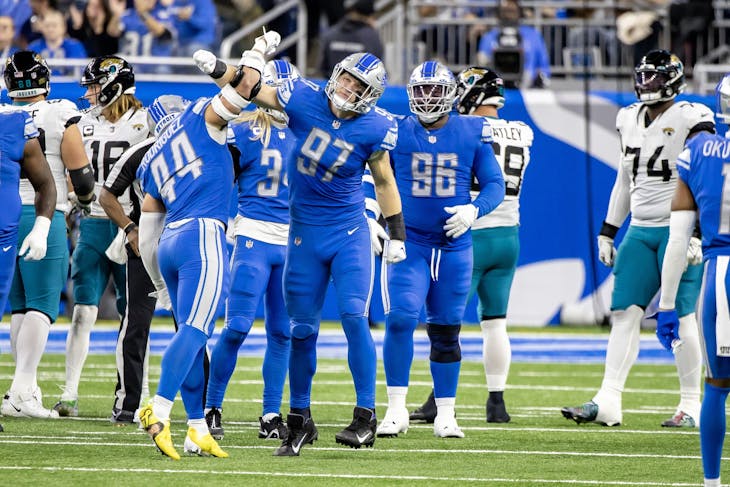
The staff members at Footballguys are full of opinions. In a Faceoff, we allow two members to voice their opinions on a specific player. One picked the high side, and the other took the low side.
High Side by Matt Waldman
Wood believes Marvin Jones has limited ability. Compared to Calvin Johnson, the receiver he’ll be replacing in Detroit, this is true. It’s also true that every receiver in the NFL compared to Johnson in his prime has limited ability.
Wood must have concluded that Jones is a below-average athlete who got open because teams were preoccupied with A.J. Green, one of the few receivers whose ability even belongs in the same zip code as Johnson. The only thing limited about Jones was his role in Cincinnati.
The Lions got a receiver with the type of athletic ability that’s important to his position, an excellent route runner, a pass catcher with terrific hand-eye coordination, and a dangerous weapon after the catch. His height-weight and role at Cal didn’t earn him the label of a future WR1 but like the former Packer Donald Driver, a top-13 fantasy receiver 4 times during a 5-season stretch, the assumption that Jones lacks the tools will prove slanderous.
Jones began his career at Cal as the primary option but moved to a possession role when Keenan Allen arrived at Berkeley and he earned a label from scouts as a possession receiver. It didn’t help that Cal’s quarterback play was sub-par for much of Jones’ career. At the Senior Bowl, Jones dominated top college cornerbacks with his vertical prowess throughout the week of practices. At the NFL Combine, Jones’ speed (80th percentile) and agility (90th percentile) scores further validated this was not a player with limited physical tools.
Jones’ ability to stop fast, drop his hips, and set up defenders with crisp, disciplined routes makes him a capable possession complement in the way that Emmanuel Sanders was considered a third wheel in Pittsburgh before he lit it up in Denver. The mischaracterization of Jones persists because he played the perimeter possession complement and part-time slot option to Green and it’s now the only think some fantasy owners thinks Jones can do.
His 10-TD season in 2013 contained multiple examples of acrobatic plays and he earned a reputation as a “jump ball maestro” in Cincinnati. When targeted last year, Pro Football Focus determined that Jones was 11th in QB rating among all receivers in the league. After the catch, Jones’ 295 yards on 65 catches was 26th among all receivers and the only options with fewer catches and more YAC were Stefon Diggs (297), Cole Beasley (309), John Brown (321), Martavis Bryant (335), Jamison Crowder (342), and Allen Hurns (332). Only Hurns and Brown were mostly perimeter receivers like Jones.
I find it difficult to watch Jones and see him as a limited player. He makes a high rate of difficult, contested catches, routinely makes the first man miss, and gets open against all types of coverage. Jones is the only true weapon in Detroit capable of getting open anywhere on the field. Golden Tate is a handy option but look for Jones to emerge as the go-to option capable of WR1 production as an 80-catch, 1200-yard, 10-touchdown option. Johnson earned approximately this total during his final season, Jones can match it.
Low Side by Jason Wood
There is a fallacy in football prognostication which leads analysts to stay too close to baseline when looking at future output. What I mean is, generally analysts will take a team or player’s prior output and tweak that baseline marginally higher or lower based on offseason factors. Rarely do you see analysts project major improvements or declines for a given team’s overall productivity. Yet, NFL history speaks to just the opposite. Very few teams maintain a consistent level of productivity, particularly when they lose (or gain) elite talent. In the case of the Detroit Lions, it’s almost laughable to think they can come close to approximating last year’s tallies without Calvin Johnson. Losing Johnson – arguably the best receiver of his generation – is something that cannot be overcome; at least through the addition of one player. Yet, fantasy owners seem ready to project Matthew Stafford as a QB1 again and are essentially handing Calvin Johnson’s otherworldly numbers to the combination of free agent Marvin Jones and tight end Eric Ebron.
Just because the Lions paid Marvin Jones big money to replace Calvin Johnson does not make him a legitimate WR1. Let’s be clear, the Lions MASSIVELY overpaid for a complementary, oft-injured receiver. Jones’ 5-year, $40 million contract ($20 million guaranteed) is laughable relative to his resume. Jones looks the part (6’2”, 199 lbs.) but his play doesn’t back it up. I always hear people talk about Jones 10 touchdowns in 2013…yet four years into career it’s clear that was the outlier, not the norm. He caught 10 scores on just 80 targets thanks to converting 9-of-9 red zone targets into scores. Yet, Jones’ supporters conveniently neglect to mention he converted just 1-of-8 red zone looks in 2015. If you take away his 10-TD season, you’re left with a receiver that isn’t particularly differentiated in any facet. He’s not a superb route-runner. He doesn’t generate an inordinate amount of yards-after-the-catch (YAC). He’s missed major time to injury. He doesn’t win contested balls very often. Does that sound like someone well suited to replace Calvin Johnson? Certainly not.
